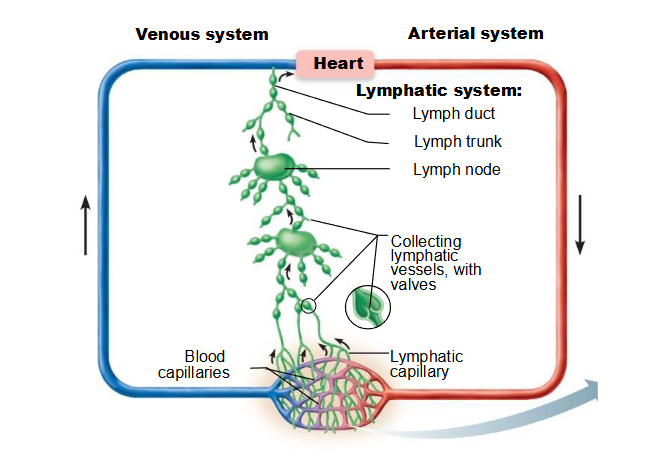-
what does the lymphatic system consist of?
- lymph nodes along the vessel network cleanse lymph as it passes through them (contain T & B lymphocytes that clean)
- one way network of lymphatic vessels (which collect 10% of the extracellular fluid the leaked out from cardriovascular capillaries and returns this fluid (called lymph) to venous blood)
-
What does extracellular fluid conatin of?
- its a fluid found outside of cells
- blood plasma (5% body weight), fluid in blood, sometimes leave capillaries to form ISF
- ISF (interstitial fluid, 15% body weight) fluid between cells within the body (except blood cells, that's plasma between), some moves into lymphatic capillaries to form lymph
- lymph (1% body weight), fluid inside lymphatic vessels, returned to blood plasma
-
What is ICF
- intracellular fluid (found within cells, 40% of body weight)
-
What is the lymphatic circulation summary?
lymphatic capillaries -> lymphatic collecting vessels (with valves) -> lymphatic ducts -> subclavian veins
-
What is the lymphatic circulation summary? (visual)

-
What is step one in lymphatic circulation?
- lymph enters lymphatic capillaries (closed ended vessels that project into cardiovascular capillary beds)
- lymphatic capillaries in the small intestine also play a role in fat absorption
-
What is step two in lymphatic circulation?
- lymphatic capillaries connect to larger lymphatic collecting vessels that have one-way valves
- lymph nodes along collecting vessels filter lymph for bacteria & debris
- transports lymph fluid away from tissues towards either:
right lymphatic duct or thoracic duct
-
What is the right lymphatic duct?
- lymph from right side of the head, chest and arm
- drains into right subclavian vein to re-enter blood circulation
-
What is the thoracic duct?
- lymph from below the ribs and the entire left side of body
- collecting vessels from below the ribs converge to an enlarged lymph vessel (cisterna chyli, most inferior portion of thoracic duct)
- thoracic duct drains into the left subclavian vein to re-enter blood circulation
-
Why does fluid flow through lymphatic? Where does it go?
- fluid flows through lymphatic collecting vessels mostly because of body movements that move fluid towards the heart
- one-way valves in the collecting vessels prevent back flow of blood
-
What are lymphoid tissues & organs? what do they do?
- contain many lymphocytes and play a key role in the body's immune system
- primary lymphoid organs and tissues (mature lymphocytes leave here and move into the blood to migrate towards secondary)
- secondary lymphoid organs and tissues
-
What are the primary lymphoid organs and tissues?
- locations where lymphoid stem cells divide and mature (become immunocompetent) which includes:
- red bone marrow: all lymphocyte stem cells arise here, site of B lymphocyte proliferation (mitosis) maturation
- thymus gland (early in dev (fetal stage) lymphocyte stem cells migrate here, site of T lymphocyte proliferation (mitosis) maturation
-
What are the secondary lymphoid organs and tissues?
- where lymphocytes detect and remove pathogens
- locations where lymphocytes are activated and proliferated further
- includes: lymph nodes, spleen, and mucosal associated lymphoid tissue (MALT)
-
What are lymph nodes?
- small masses of lymphoid tissue along the lymphatic collecting vessels
- high concentrations of lymph nodes are located in: cervical (neck), axillary (armpit), inguinal (groin), intestinal, pelvic regions
-
What is the spleen?
- located in the left side of abdominal cavity, just below diaphragm next to stomach
- filters (cleans) blood by removing pathogens (organisms that can cause disease like bacteria or viruses), old and defective blood, and cellular debris
-
What is Mucosal associated lymphoid tissue (MALT)? What does it do?
- traps and removes pathogens at points of entry into the body
- includes tonsils, appendix, and other lymphoid tissues on mucous membranes
-
Where are some MALTs?
- lingual (1) bumpy nodules on posterior part of tongue
- palatine (2) in oropharynx, these are you tonsils
- pharyngeal (1) in posterior nasopharynx (refered to adenoids when swollen)

